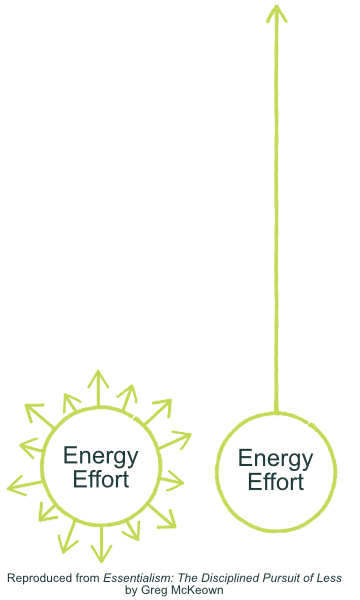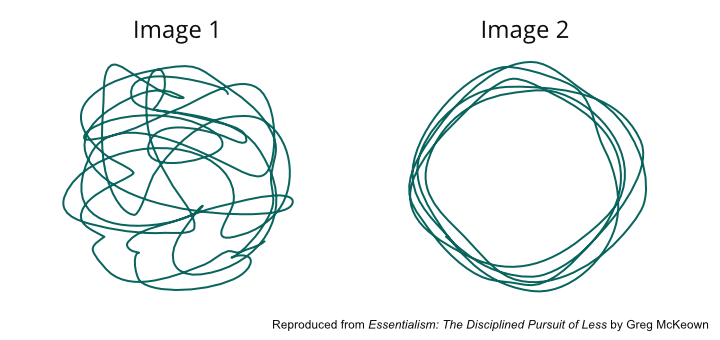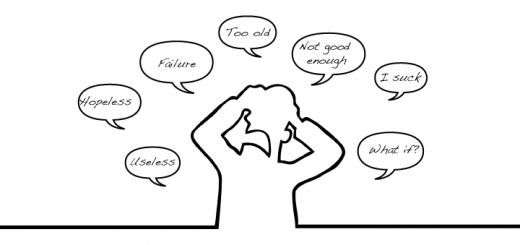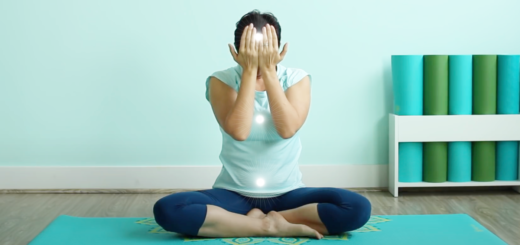Less but better: Essentialism in yoga practice design
7I’ve been reading an interesting book called Essentialism: The Disciplined Pursuit of Less by Greg McKeown. I really connect to the main point of the book which is the idea that we need to strive for “less but better.” This lesson applies to every area of our lives: how much and what kind of stuff we buy, how many and which tasks we take on – in general, how we choose to spend our resources, efforts and energy. But as I was reading the book, it became abundantly clear that this main principle also very accurately describes my approach to yoga practice design.
When we create a yoga practice, it’s very easy to fall into the trap of doing too much without making any significant progress in any one area. We usually have the best intentions: there are so many poses that we can include, so many interesting techniques and ideas, and our students are all different – who knows what will resonate with each one, right? So we pile up all sorts of things into one yoga class and hope that the overall effect with be useful to our students. However, when we disperse our efforts and energy in that way, we might end up accomplishing very little. Here is a useful image from the book that illustrates how the same amount of effort can be concentrated or dispersed.

“In both images the same amount of effort is exerted. In the image on the left, the energy is divided into many different activities. The result is that we have the unfulfilling experience of making a millimeter of progress in a million directions. In the image on the right, the energy is given to fewer activities. The result is that by investing in fewer things we have the satisfying experience of making significant progress in the things that matter most.”(1)
In terms of yoga practice, it is the difference between let’s say focusing your efforts on dealing with neck tension (concentrated effort), or trying to address the neck tension, plus stretch the hamstrings, plus work on core strength, plus experiment with belly breathing, plus reflect on a poem by Rumi, plus promote a better outlook on life, etc. The decision that each yoga teacher has to make is whether she chooses to dabble in a little bit of everything without significant impact, or to concentrate her efforts and make good progress in one area. We simply cannot fit it all in; if we try, we end up diluting the original intention.
I am sure you yourself had experienced yoga classes that felt like this (Image 1) and like this (Image 2).

The first one leaves you feeling discombobulated and pulled in many different directions, while the second one helps you feel more centered and clear. In the second example the teacher probably made conscious choices about what to include in the practice with a clear intention in mind. She probably selected vital few practices from the trivial many, eliminated the nonessentials, articulated her intention to you, and created a clear path for you to follow. When the teacher has a clear vision of what she is trying to accomplish, it is much easier to communicate that vision to her students.
Since the ultimate purpose of yoga is to facilitate mental clarity, it seems reasonable to deploy the second approach. Then why is it so hard to do less and keep our classes streamlined? There are few very legitimate reasons why this can happen:
- Too many choices. There are so many yoga poses, breathing techniques, meditations and general ideas worth exploring floating out there, that it can be very difficult to choose the most relevant ones. We want our students to experience them all, “the preponderance of choice has overwhelmed our ability to manage it.”(1) One of the most important skills we can cultivate as yoga teachers is to be able to make those choices.
- Too much social pressure. This pressure can come from your students requesting specific poses or practices, it can come from your teacher training program that advises you to attend to every part of the body within a single yoga class, it can come from your fellow yoga teachers who are used to doing things that way. It can come from general expectations or sequences in yoga magazines that can create this feeling of “I should be teaching this …” Ultimately, it’s up to you, because you are the boss. You are the one who makes decisions for your classes, nobody else. Do what makes the most sense to you (including whether or not you choose to follow advice in this article :))
- The idea that “you can have it all”. We cannot have it all within each yoga class. “When we try to do it all and have it all, we find ourselves making trade-offs at the margins that we would never take on as our intentional strategy.”(1) We end up rushing from one pose to the next, compromising safety of beginning students in our effort to please more experienced ones, cramping more and more stuff into each class even if our students cannot keep up or truly absorb what we are teaching. We would never choose to teach our classes like that intentionally, but it might end being a trade-off for trying to “have it all”.
It is not easy to switch our thinking from “having it all” to “less but better” when it comes to yoga practice design. Over the next few weeks we will explore how we can streamline our thinking and to deliberately eliminate the nonessentials in our yoga classes that do not drive our intention forward. If this style of yoga practice design appeals to you, tune in!
[jetpack_subscription_form]
Resources
- Essentialism: The Disciplined Pursuit of Less by Greg McKeown




















Olga, once again you hit the nail on the head. Thank you for this insight!
Olga this is a powerful and essential message to us all – in many arenas if life! Thank you for continued wisdom and insight .?❤️
Spot on.
Yes, yes, yes! Thank you once again, Olga.
Olga, thank you for the insights and the commitment to share such valuable (to me) information, I can relate with this post as I teach basic yoga and a power yoga style in a corporate setting, often I find it difficult to please everyone although I understand that’s just hard to do, I strive for designing classes that have a theme or a certain part of the body to focus on. Thank you and I will stay connected to keep reading your material!<3
Gracias, desde Madrid.
Es muy interesante tu punto de vista.
Desde 2006 imparto clases de yoga en un centro cultural, los grupos son muy heterogéneos.
Por lo que me resultó en su día muy difícil planificar mis clases.
Sigue siendo un reto para mi, conseguir mis objetivos.
Te seguiré leyendo.
Gracias
¡Gracias por tu comentario! Enseñar clases mixtas es siempre un reto; Encuentro que la mejor experiencia viene con la práctica. Me alegra saber que sigue estudiando y espero que implemente esas sugerencias en su enseñanza.